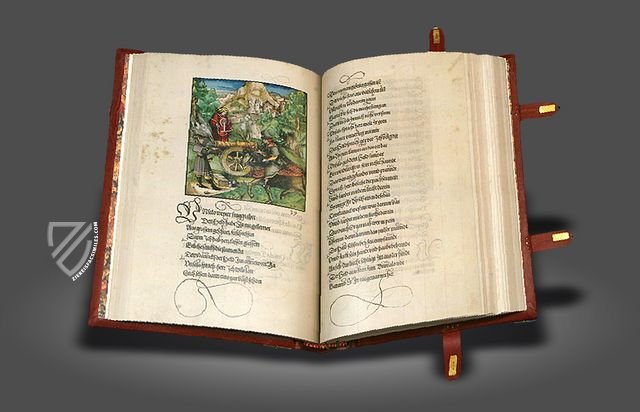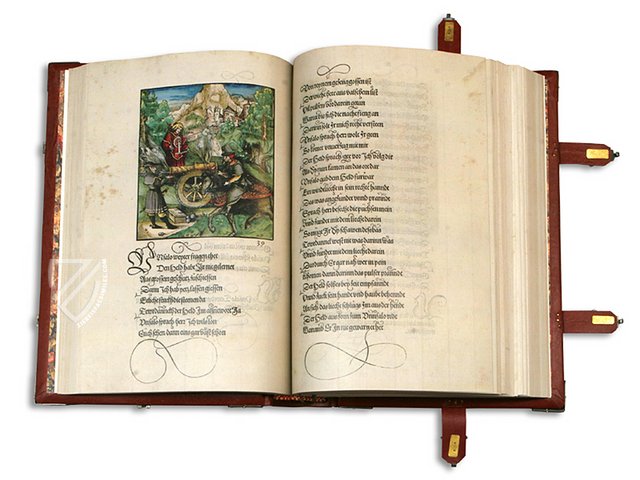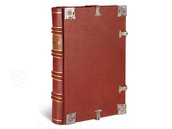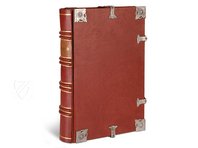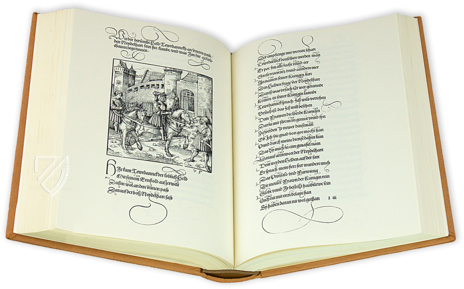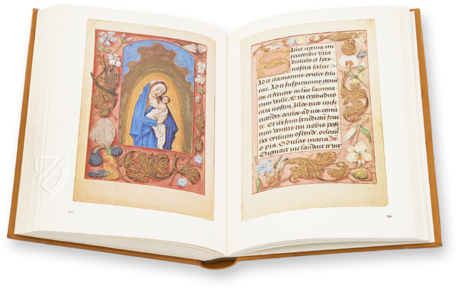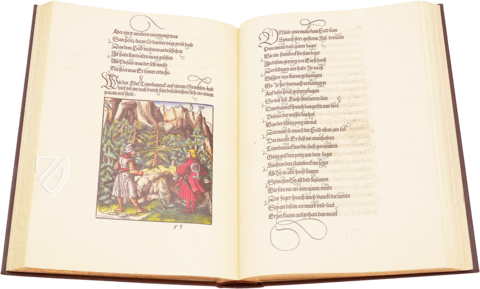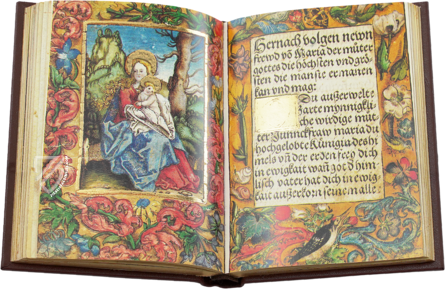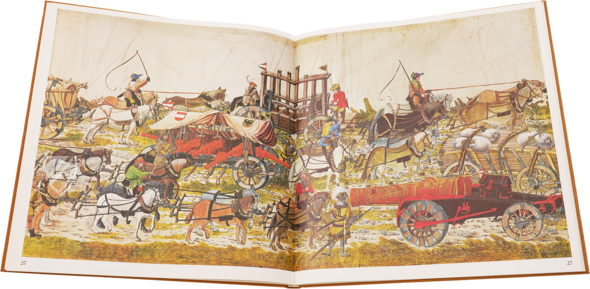Maximilian I and Melchior Pfintzing: Teuerdank
(1,000€ - 3,000€)
The amazing tales of the knight Teuerdank (also spelled Theuerdank) and his companion, Ehrenhold, comprise the last great verse epic of the Late Middle Ages. Teuerdank is the alter ego of Emperor Maximilian when was still a young man. The courageous knight's journey to woo his future wife, Mary of Burgundy, and his triumph in battles and other dangerous situations are the focus of this highly embellished “real-life” story of Emperor Maximilian I (1459–1519). Elected Holy Roman Emperor in 1508, Maximilian was a great patron of the arts and commissioned a trilogy of ornate, illustrated books to immortalize his existence.
Maximilian I and Melchior Pfintzing: Teuerdank
Theuerdank, the only volume to be published during the Emperor’s lifetime, was composed by Melchior Pfinzing based on Maximilian's rather fanciful draft. The 118 ornate, gold-adorned woodcuts – one for each chapter – were made by Hans Burgkmair the Elder, Hans Schäufelein, and Leonhard Beck, while the typeface – known as the “Theuerdank typeface” and characterized by its striking “elephant trunks” – was specially designed for the book by the printing workshop of Hans Schönsperger the Elder. Produced in 1517 in Nuremberg, this triumph of book design has been described as one of the greatest books of the German Renaissance.
A Renaissance Humanist Emperor
Maximilian I (1459–1519) – Archduke of Austria, King of Germany German, and Holy Roman Emperor (1493–1519) – was an important patron of the arts in the 16th century. We can safely say that he was one of the first Humanist emperors of the Renaissance, enthusiastic about new scientific inventions as well as the arts. He made his court a major center for the arts. Maximilian supported music, planned grand architectural monuments, collected an important library and encouraged printing. He was also highly interested by his family history, commissioning genealogical studies to provide him with eminent ancestors including Caesar, Charlemagne and King Arthur. Maximilian was himself a prolific author. Teuerdank is traditionally ascribed to him, however it should more correctly be attributed to Melchior Pfintzing, his chaplain, who worked extensively on the text in accordance with the Emperor’s instructions. Some commentators also credit Maximilian’s secretary, Marx Treitzsauerwein, with some responsibility for the writing. Certainly, the whole concept took a long time to complete: originally planned in 1505, the poem did not near completion until 1512, and took a further five years to be produced.
The Chivalric Tale
The story is a long allegorical courtly poem written in rhymed couplets, a fictionalized account of the adventures of Maximilian. In 1477, he travels to the Netherlands to claim his bride, Mary of Burgundy, and her kingdom. The Emperor is portrayed as the chivalric knight Teuerdank (roughly translated as “noble thought”) accompanied by his trusty companion Erenhold. The story begins when Romreich (Charles of Burgundy), the father of Erenreich (Mary) dies. Throughout his journey Teuerdank encounters no less than eighty different life threatening adventures, which are engineered by Erenreich’s most powerful vassals – Fürwittig, Neidelhart and Unfallo – whose power is threatened by Teuerdank; they therefore try to kill him, thereby preventing the marriage. Thus, Teuerdank encounters dangerous hunting expeditions in which he is given unsafe weapons; he is led into the path of organized ‘accidents’ such as broken staircases, rockslides and avalanches; he is given poisoned food to eat; he sets sail in stormy seas and his ship is set on fire; mercenaries are paid to engage him in jousts. Ultimately, of course, our hero overcomes these perils by his bravery, foresight, skill and knowledge. The treachery of his three adversaries is revealed and they are executed. The book ends as Mary promises to marry Teuerdank on the provision that he first furthers his honor by undertaking a crusade against the Turks.
Maximilian as an Author
One of three autobiographical texts planned by Maximilian, Teuerdank was the only work finished in his lifetime. The Weisskunig (‘White King’) was to have been the first instalment, celebrating his childhood and youthful exploits. Although 237 illustrations were created for this, it was not published until 1775, and then only in a fragmentary version. The last part, the Freydal, was even less complete when Maximilian died in 1519. Teuerdank, meanwhile, enjoyed considerable success. While the first edition of 1517 was intended for private distribution, an edition for general sale appeared two years later and subsequent editions were produced regularly throughout the 16th century. Contemporary enthusiasm for it has been attributed partly to Maximilian’s popularity and partly to its striking illustrations and fine design. As a work of literature, it is disparaged by the Oxford Companion to German Literature for having wooden verse and repetitive construction.
An Exemplary Early Print
The full title of the work translates as The Adventures and a Portion of the Story of the Praiseworthy, Valiant, and Highly-Renowned Hero and Knight, Lord Tewrdannckh. Originally printed on vellum, the book was made with a special, ornamental type characterized by enormous flourishes. At first glance, it is often mistaken for manuscript. This black-letter typeface was based on a gothic script used in the Imperial Chancery; it was first used in 1513 in the Prayer Book of Maximilian I and evolved into the font known as Fraktur. Considering that the book was produced only some sixty years after the introduction of printing by moveable type, its fine execution is all the more remarkable. It was printed by Hans Schönsperger the Elder, who had been appointed Maximilian’s printer for life in 1508. The result of his work was a major achievement, although by no means perfect: mistakes in the original typesetting have been carefully corrected throughout by means of pasted lines of text.
Codicology
- Alternative Titles
- Maximilian I. und Melchior Pfintzing: Theuerdank
- Size / Format
- 648 pages / 34.5 × 23.0 cm
- Origin
- Germany
- Date
- 1517
- Epochs
- Style
- Genre
- Language
- Script
- A Blackletter typeface based on a Gothic script used in the Imperial Chancery; first used in 1513 for the Prayer-Book of Maximilian I; basis of the later 'Fraktur' type
- Illustrations
- 118 ornate, gold-adorned woodcuts – one for each chapter
- Content
- An allegorical courtly poem written in rhymed couplets with a fictionalized account of the adventures of Maximilian
- Patron
- Emperor Maximilian I (1459–1519)
- Artist / School
- Emperor Maximilian I (1459–1519) (author)
Melchior Pfintzing (1481–1535) (author)
Hans Burgkmair the Elder (1473–1531) (printer)
Hans Schäufelein (ca. 1480 – ca. 1540) (printer)
Leonhard Beck (ca. 1480–1542) (printer)
#1 Maximilian I and Melchior Pfintzing Teuerdank
(1,000€ - 3,000€)
- Treatises / Secular Books
- Apocalypses / Beatus
- Astronomy / Astrology
- Bestiaries
- Bibles / Gospels
- Chronicles / History / Law
- Geography / Maps
- Saints' Lives
- Islam / Oriental
- Judaism / Hebrew
- Single Leaf Collections
- Leonardo da Vinci
- Literature / Poetry
- Liturgical Manuscripts
- Medicine / Botany / Alchemy
- Music
- Mythology / Prophecies
- Psalters
- Other Religious Books
- Games / Hunting
- Private Devotion Books
- Other Genres
- Afghanistan
- Armenia
- Austria
- Belgium
- Belize
- Bosnia and Herzegovina
- China
- Colombia
- Costa Rica
- Croatia
- Cyprus
- Czech Republic
- Denmark
- Egypt
- El Salvador
- Ethiopia
- France
- Germany
- Greece
- Guatemala
- Honduras
- Hungary
- India
- Iran
- Iraq
- Israel
- Italy
- Japan
- Jordan
- Kazakhstan
- Kyrgyzstan
- Lebanon
- Liechtenstein
- Luxembourg
- Mexico
- Morocco
- Netherlands
- Palestine
- Panama
- Peru
- Poland
- Portugal
- Romania
- Russia
- Serbia
- Spain
- Sri Lanka
- Sweden
- Switzerland
- Syria
- Tajikistan
- Turkey
- Turkmenistan
- Ukraine
- United Kingdom
- United States
- Uzbekistan
- Vatican City
- A. Oosthoek, van Holkema & Warendorf
- Aboca Museum
- Ajuntament de Valencia
- Akademie Verlag
- Akademische Druck- u. Verlagsanstalt (ADEVA)
- Aldo Ausilio Editore - Bottega d’Erasmo
- Alecto Historical Editions
- Alkuin Verlag
- Almqvist & Wiksell
- Amilcare Pizzi
- Andreas & Andreas Verlagsbuchhandlung
- Archa 90
- Archiv Verlag
- Archivi Edizioni
- Arnold Verlag
- ARS
- Ars Magna
- ArtCodex
- AyN Ediciones
- Azimuth Editions
- Badenia Verlag
- Bärenreiter-Verlag
- Belser Verlag
- Belser Verlag / WK Wertkontor
- Benziger Verlag
- Bernardinum Wydawnictwo
- BiblioGemma
- Biblioteca Apostolica Vaticana (Vaticanstadt, Vaticanstadt)
- Bibliotheca Palatina Faksimile Verlag
- Bibliotheca Rara
- Boydell & Brewer
- Bramante Edizioni
- Bredius Genootschap
- Brepols Publishers
- British Library
- C. Weckesser
- Caixa Catalunya
- Canesi
- CAPSA, Ars Scriptoria
- Caratzas Brothers, Publishers
- Carus Verlag
- Casamassima Libri
- Centrum Cartographie Verlag GmbH
- Chavane Verlag
- Christian Brandstätter Verlag
- Circulo Cientifico
- Club Bibliófilo Versol
- Club du Livre
- CM Editores
- Collegium Graphicum
- Collezione Apocrifa Da Vinci
- Comissão Nacional para as Comemorações dos Descobrimentos Portugueses
- Coron Verlag
- Corvina
- CTHS
- D. S. Brewer
- Damon
- De Agostini/UTET
- De Nederlandsche Boekhandel
- De Schutter
- Deuschle & Stemmle
- Deutscher Verlag für Kunstwissenschaft
- DIAMM
- Droz
- E. Schreiber Graphische Kunstanstalten
- Ediciones Boreal
- Ediciones Grial
- Ediclube
- Edições Inapa
- Edilan
- Editalia
- Edition Deuschle
- Edition Georg Popp
- Edition Leipzig
- Edition Libri Illustri
- Editiones Reales Sitios S. L.
- Éditions de l'Oiseau Lyre
- Editions Medicina Rara
- Editorial Casariego
- Editorial Mintzoa
- Editrice Antenore
- Editrice Velar
- Edizioni Edison
- Egeria, S.L.
- Eikon Editores
- Electa
- Emery Walker Limited
- Enciclopèdia Catalana
- Eos-Verlag
- Ephesus Publishing
- Ernst Battenberg
- Eugrammia Press
- Extraordinary Editions
- Fackelverlag
- Facsimila Art & Edition
- Facsimile Editions Ltd.
- Facsimilia Art & Edition Ebert KG
- Faksimile Verlag
- Feuermann Verlag
- Folger Shakespeare Library
- Franco Cosimo Panini Editore
- Friedrich Wittig Verlag
- Fundación Hullera Vasco-Leonesa
- G. Braziller
- Gabriele Mazzotta Editore
- Gebr. Mann Verlag
- Gesellschaft für graphische Industrie
- Getty Research Institute
- Giovanni Domenico de Rossi
- Giunti Editore
- Graffiti
- Grafica European Center of Fine Arts
- Guido Pressler
- Guillermo Blazquez
- Gustav Kiepenheuer
- H. N. Abrams
- Harrassowitz
- Harvard University Press
- Helikon
- Hendrickson Publishers
- Henning Oppermann
- Herder Verlag
- Hes & De Graaf Publishers
- Hoepli
- Holbein-Verlag
- Houghton Library
- Hugo Schmidt Verlag
- Idion Verlag
- Il Bulino, edizioni d'arte
- ILte
- Imago
- Insel Verlag
- Insel-Verlag Anton Kippenberger
- Instituto de Estudios Altoaragoneses
- Instituto Nacional de Antropología e Historia
- Introligatornia Budnik Jerzy
- Istituto dell'Enciclopedia Italiana - Treccani
- Istituto Ellenico di Studi Bizantini e Postbizantini
- Istituto Geografico De Agostini
- Istituto Poligrafico e Zecca dello Stato
- Italarte Art Establishments
- Jan Thorbecke Verlag
- Johnson Reprint Corporation
- Josef Stocker
- Josef Stocker-Schmid
- Jugoslavija
- Karl W. Hiersemann
- Kasper Straube
- Kaydeda Ediciones
- Kindler Verlag / Coron Verlag
- Kodansha International Ltd.
- Konrad Kölbl Verlag
- Kurt Wolff Verlag
- La Liberia dello Stato
- La Linea Editrice
- La Meta Editore
- Lambert Schneider
- Landeskreditbank Baden-Württemberg
- Leo S. Olschki
- Les Incunables
- Liber Artis
- Library of Congress
- Libreria Musicale Italiana
- Lichtdruck
- Lito Immagine Editore
- Lumen Artis
- Lund Humphries
- M. Moleiro Editor
- Maison des Sciences de l'homme et de la société de Poitiers
- Manuscriptum
- Martinus Nijhoff
- Maruzen-Yushodo Co. Ltd.
- MASA
- Massada Publishers
- McGraw-Hill
- Metropolitan Museum of Art
- Militos
- Millennium Liber
- Müller & Schindler
- Nahar - Stavit
- Nahar and Steimatzky
- National Library of Wales
- Neri Pozza
- Nova Charta
- Oceanum Verlag
- Odeon
- Orbis Mediaevalis
- Orbis Pictus
- Österreichische Staatsdruckerei
- Oxford University Press
- Pageant Books
- Parzellers Buchverlag
- Patrimonio Ediciones
- Pattloch Verlag
- PIAF
- Pieper Verlag
- Plon-Nourrit et cie
- Poligrafiche Bolis
- Presses Universitaires de Strasbourg
- Prestel Verlag
- Princeton University Press
- Prisma Verlag
- Priuli & Verlucca, editori
- Pro Sport Verlag
- Propyläen Verlag
- Pytheas Books
- Quaternio Verlag Luzern
- Reales Sitios
- Recht-Verlag
- Reichert Verlag
- Reichsdruckerei
- Reprint Verlag
- Riehn & Reusch
- Roberto Vattori Editore
- Rosenkilde and Bagger
- Roxburghe Club
- Salerno Editrice
- Saltellus Press
- Sandoz
- Sarajevo Svjetlost
- Schöck ArtPrint Kft.
- Schulsinger Brothers
- Scolar Press
- Scrinium
- Scripta Maneant
- Scriptorium
- Shazar
- Siloé, arte y bibliofilia
- SISMEL - Edizioni del Galluzzo
- Sociedad Mexicana de Antropología
- Société des Bibliophiles & Iconophiles de Belgique
- Soncin Publishing
- Sorli Ediciones
- Stainer and Bell
- Studer
- Styria Verlag
- Sumptibus Pragopress
- Szegedi Tudomànyegyetem
- Taberna Libraria
- Tarshish Books
- Taschen
- Tempus Libri
- Testimonio Compañía Editorial
- Thames and Hudson
- The Clear Vue Publishing Partnership Limited
- The Facsimile Codex
- The Folio Society
- The Marquess of Normanby
- The Richard III and Yorkist History Trust
- Tip.Le.Co
- TouchArt
- TREC Publishing House
- TRI Publishing Co.
- Trident Editore
- Tuliba Collection
- Typis Regiae Officinae Polygraphicae
- Union Verlag Berlin
- Universidad de Granada
- University of California Press
- University of Chicago Press
- Urs Graf
- Vallecchi
- Van Wijnen
- VCH, Acta Humaniora
- VDI Verlag
- VEB Deutscher Verlag für Musik
- Verlag Anton Pustet / Andreas Verlag
- Verlag Bibliophile Drucke Josef Stocker
- Verlag der Münchner Drucke
- Verlag für Regionalgeschichte
- Verlag Styria
- Vicent Garcia Editores
- W. Turnowski Ltd.
- W. Turnowsky
- Waanders Printers
- Wiener Mechitharisten-Congregation (Wien, Österreich)
- Wissenschaftliche Buchgesellschaft
- Wissenschaftliche Verlagsgesellschaft
- Wydawnictwo Dolnoslaskie
- Xuntanza Editorial
- Zakład Narodowy
- Zollikofer AG

